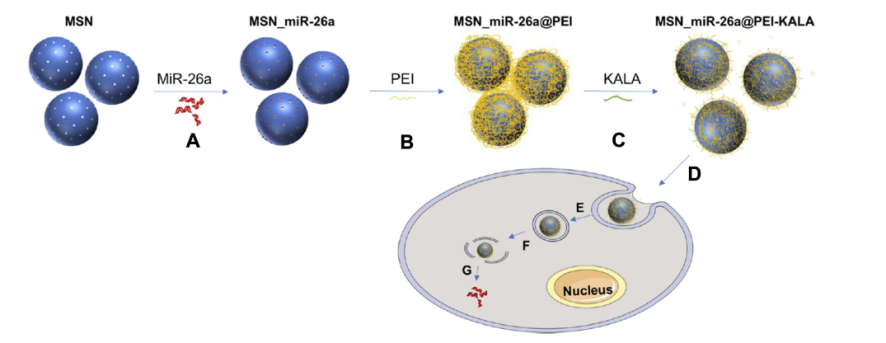原文献:
Effects of miR-26a on Osteogenic Differentiation of Bone Marrow Mesenchymal Stem Cells by a Mesoporous Silica Nanoparticle - PEI - Peptide System
文献链接:
https://pubmed.ncbi.nlm.nih.gov/32158207/
相关产品:
作者:
Jia Yan, Xiaoli Lu, Xinchen Zhu ,Xiaokun Hu, Lili Wang ,Jun Qian ,Feimin Zhang ,Mei Liu
摘要:Introduction: RNA-based therapy for bone repair and regeneration is a highly safe and effective approach, which has been extensively investigated in recent years. However, the molecular stability of RNA agents still remains insufficient for clinical application. High porosity, tunable size, and ideal biodegradability and biosafety are a few of the characters of mesoporous silicon nanoparticles (MSNs) that render them a promising biomaterial carrier for RNA treatment.
Materials and Methods: In this study, a novel miR-26a delivery system was constructed based on MSNs. Next, we assessed the miRNA protection of the delivery vehicles. Then, rat bone marrow mesenchymal stem cells (rBMSCs) were incubated with the vectors, and the transfection efficiency, cellular uptake, and effects on cell viability and osteogenic differentiation were evaluated.
Results: The results demonstrated that the vectors protected miR-26a from degradation in vitro and delivered it into the cytoplasm. A relatively low concentration of the delivery systems significantly increased osteogenic differentiation of rBMSCs.
Conclusion: The vectors constructed in our study provide new methods and strategies for the delivery of microRNAs in bone tissue engineering.
基于rna的骨修复和再生应用是一种安全有效的方法,但RNA化合物的分子稳定性仍不足以供临床应用。介孔二氧化硅纳米颗粒(MSNs)具有高孔隙率和比表面积、可调尺寸、生物降解性和生物安全性,是一种RNA处理生物材料载体,研究基于单分散二氧化硅构建了一种新型的miR-26a递送系统。制备过程如下:

图:介孔二氧化硅
将MSNs加入微离心管中,分散在乙醇中,加入盐酸胍溶液。在试管中加入miR-26a模拟或fam标记的miR-26a模拟或模拟NC或无rnase的水。用超声波装置分散混合物,然后在摇晃。离心后,取出上清液,用乙醇冲洗。沉积物在乙醇中重悬,然后用超声波装置良好地分散几分钟。随后,逐滴加入等体积的PEI乙醇溶液。超声分散后,离心,上清分离,乙醇冲洗沉淀物。将得到的颗粒在乙醇中重悬,然后加入 SPDP溶液。然后超声处理,沉淀,然后离心,弃上清。用无rnase的ddH2O洗涤两次,分散颗粒,加入KALA肽溶液。超声分散后,静置,离心。用水冲洗两次,向颗粒中加入ddH2O,测定输送系统的最终浓度,载体存储在−20°C,供以后使用。

图:miR-26a载体的制备和递送流程图。
结论:实验证实了该载体可保护miR-26a在体外不被降解,并将其传递到细胞质中。相对较低浓度的传递系统增加了r骨髓间充质干细胞的成骨分化。利用单分散二氧化硅作为载体传递microrna以促进成骨分化的有效性。此外,MSN_miR-26a@PEI-KALA在其表面有大量可用的基团,可以进一步用功能聚合物进行修饰,用于主动靶向干细胞,增强环境响应性和生物相容性。

 2024-12-18 作者:ZJ 来源:
2024-12-18 作者:ZJ 来源:

